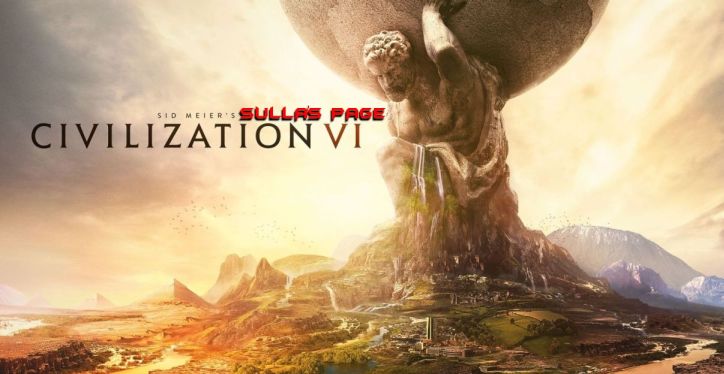

Turn 60 began with the establishment of my fifth city on the southern coast:

|
Sullla: The big news for the turn is that I planted Hispalis as expected, making me the first player to five cities. This is my first city not on fresh water, and therefore there are only 3 points of housing here. Hispalis will trigger the housing penalty at size 2! I can fix that temporarily though: a plantation on the spices and a pasture on the cows each provide 0.5 housing, so together they let the city grow to size 3 before becoming unhealthy, and I should be able to grow through the housing penalty to size 4. That's enough to work all of the good tiles: spices, cows, iron, and stone. It won't be too much longer until I can start throwing down Bath districts, and that will get this city up to 9 housing (!) Again, the plan is to skip granaries and build Bath districts instead to save on precious early game production. I've also already thrown down the Commercial district to lock in its cost. One really nice thing about Hispalis is that it will be able to share the grassland hill tiles to the west with the capital, which could be highly useful down the road. I will need more builders, as always! Also note that the founding of this city boosted Sailing tech, and I swapped back to it after investing research into Apprenticeship next turn. After thinking about it, I'm pretty confident that I can have everything in place for a roughly Turn 75 attack, and so I'll be delaying Apprenticeship tech to push for Shipbuilding and Iron Working next. It's going to take some tricky builder/techs/civic management to line everything up, while I'll be detailing over the next dozen or so turns. |
This was a major decision on the upcoming research path. Apprenticeship is one of the key techs in Civ6, not just because it unlocks Industrial districts but because it grants +1 production to all mines. In a game where production tends to be scarce, upgrading all of your mines for free in one stroke is not something to be ignored. However, I had been thinking about attack timings, and I thought that I could get everything lined up for an invasion in a little over a dozen more turns. I wanted Shipbuilding tech to be able to embark my units, and since that's a fairly expensive tech, I wanted to try and land the boost: build two galleys. Hispalis was going to help me with that, since none of my other cities were on the coast. It was going to take some creative micro to pull it all off, but I had plenty of time for thinking between turns.
So how do you get a couple of boats out of a new city with little production? The same way that you do in Civ4: chop down the forests!

|
Sullla: Despite what the cursor hover might be showing here, I used this builder to construct a plantation at Hispalis. As I mentioned before, the 4/1 spices tile is the best one to work at size 1, and therefore I might as well improve it first. I also want to improve the spices and the cattle tile quickly (using the other builder that just popped out of Ravenna) to avoid hitting the housing penalty at size 2. The new builder will improve the cows, then the iron, and then use the final builder charge on a forest chop. I highlighted the chop here to demonstrate the amount of production that I'll be getting from chopping a forest. It increases every time I discover a new civic, just like how the districts scale up in cost, so I will be getting slightly more production when I do the future forest chop. Probably about 55 production, something like that. Why do I want to chop a forest here? Well, I need Shipbuilding tech to embark units, and the boost for Shipbuilding is to own two galleys. I need to trigger that tech boost to drop the cost of Shipbuilding tech from 200 beakers (14 turns) to 100 beakers (7 turns) to speed up my planned attack. The galleys cost 65 production each, and Hispalis is the only city that can build them because it's the only one of my cities actually located on the coast. So the plan is to funnel a forest chop into Hispalis using the Maritime Industries policy card (+100% production for naval units) and use that to trigger the boost for the tech. That forest chop will arrive on Turn 68, and so I will have to manipulate the civic swaps to be in the Maritime Industries policy on Turn 68. It's a lousy policy otherwise, which means I'll also try to set things up to leave that policy immediately thereafter. In the meantime, since I need 130 production for two galleys and the forest chop will only produce about 110 production, Hispalis started on a galley this turn. With its own native production, it will be able to make up the ~20 production that the chop falls short on providing. 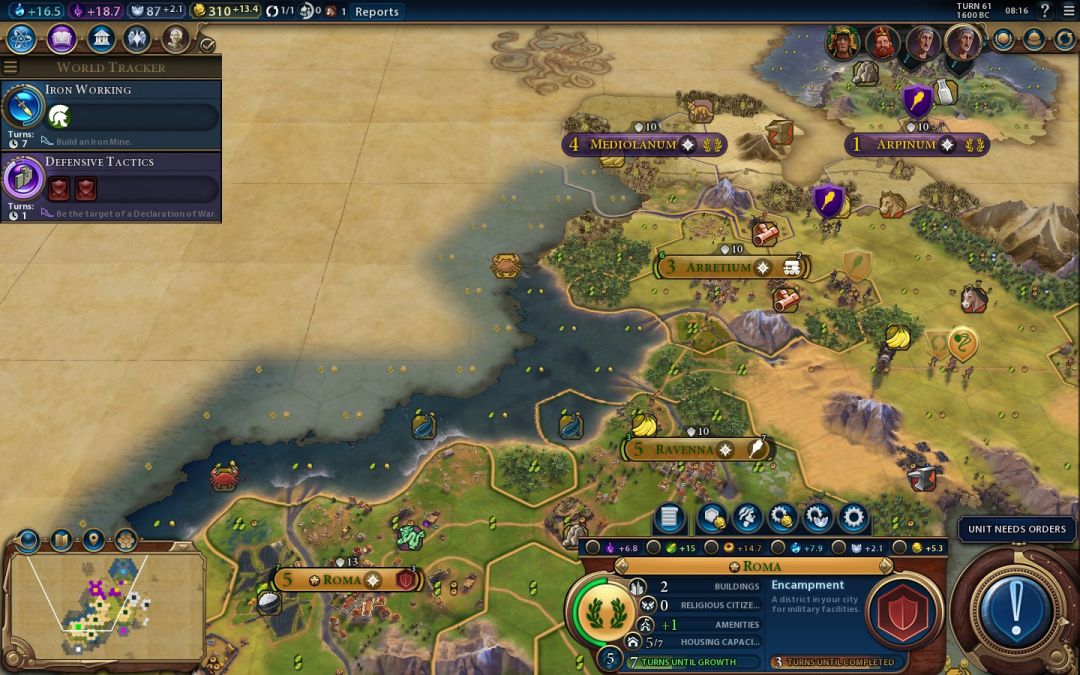
I keep talking about this planned attack, so I should talk a little bit more about how I intend to set it up tactically. It all comes down to attacking from an unexpected direction. TheArchduke has warriors watching the front door to Mediolanum and Arpinum, and the terrain around Mediolanum in particular is difficult to attack into. Lots of rivers and hills and rainforest tiles, and in particular there are two one-tile choke points to the south and east of the city that would be hard to force my way through. Rather than trying to crash through the front door, I'm hoping to slip in through the unguarded back door. If you look carefully at the water tiles in this screenshot, you can see that almost all of them have the 1 food / 1 gold yield. That means that they are coastal tiles, not ocean tiles, and therefore embarkable by land units at Shipbuilding tech. See how the water just above my capital is all coastal tiles? This is a mirrored map, so it must be the same for TheArchduke's capital. And the distance by water, with my units moving 3 tiles per turn, is actually quite short indeed. Borders in Civ6 only see 1 tile away, and that means I can move almost the whole distance while remaining in the fog of war. What's TheArchduke going to do if he opens the save one day and there are 4 legions + 1 horseman + Great General all a tile away from landing next to his capital? With all his units off guarding the borders, and with Civ6's extremely slow movement rules? Hopefully nothing. Even better, TheArchduke's capital is by far his best city, and the only one that has any kind of serious production capacity. If I can snap it up at the outset of a war, he'll be effectively helpless thereafter. Lot of "ifs" there, but we'll see what happens. I had Ravenna start a warrior following its builder. I will be in Agoge policy again next turn, and I need another unit for this upcoming attack. There simply isn't much time remaining; I'm hoping to put my units in the water around Turn 70 and launch the attack around Turn 75. Arretium has a warrior mostly done that it will finish, Ravenna produces another, and the capital should be able to do two more; that leaves me with 6 total warriors, 4 of which I will be able to upgrade immediately and use for the attack. The other two I can save for later when I have more gold on hand. I set the overflow from the Sailing research into Iron Working, which I want to research almost to 50% without actually reaching 50%, so that when I build the iron mine in a few turns the boost won't quite finish the tech. Remember, I can't build warriors once I finish Iron Working tech. So I will almost finish Iron Working, research half of Shipbuilding tech, then go back and finish Iron Working. Who said this game doesn't have micromanagement? 
Aquileia requires another complicated coordination exercise to get everything to come out the way I want. The plan is to use the forest chop on the grassland hill to complete Ancient walls (80 production) and a horseman (80 production) for the upcoming attack. This has to be lined up very carefully to work, however. First I need to build a pasture on the horses to be able to train horsemen at all in Aquileia. Therefore the builder has to do that before the forest chop. Second, the forest chop is only going to produce about 110 production even with the Limes policy (+100% production towards defensive buildings) in place, and that's quite a bit short of what I need. What I'm going to do here is take advantage of Civ6's wonky production overflow mechanics. Unlike in Civ4, production modifiers are not divided back out of overflow into the next build; in other words, I will still get the +100% production on overflow from constructing city walls even if the next build has nothing to do with city walls. So here's the plan: swap into Limes policy next turn, have Aquileia build towards Ancient walls with that policy card in place, but DO NOT FINISH the walls, and then use the production overflow from the chop to knock out the horseman in a single turn. I'm essentially getting +100% production towards the horseman by virtue of how overflow works. And with doubled production, Aquileia should be able to make up the gap of ~70 production needed on its own, since it will be getting 8 base production -> 16 modified production with Limes in place. Forest chop comes in on Turn 67, I swap out of Limes and into Maritime Industries on Turn 68 for the other forest chop, and the horseman hopefully finishes on Turn 68, in time to scamper over to the coast and embark for the upcoming attack. I should have just barely enough gold to reach 440 for four warrior -> legion upgrades. I definitely could have used that other copper tile with its +2 gold yield at Arretium! |
The explanation of how to use production overflow in Civ6 became a little bit complicated in my thread, but the main idea is that this game doesn't bother to check if the same modifier applies to the new item in the build queue - it simply overflows all the production from the previous item without alteration. Here at Aquileia, I could burn a forest chop with +100% production in play from the Limes policy and then still get the +100% production on the overflow, even on a horseman that should be unaffected by that policy. (Note that this is a change from Civ4, where production modifiers are divided back out of overflow and the modifiers affecting the new item reapplied.) This wasn't just a micromanagement trick either: I wanted city walls in Aquileia for defense in case Yuris or teh tried to attack while my army was off in TheArchduke's territory. This planned forest chop would give me another strong unit for my attack and help fortify my flanks all in one gesture.
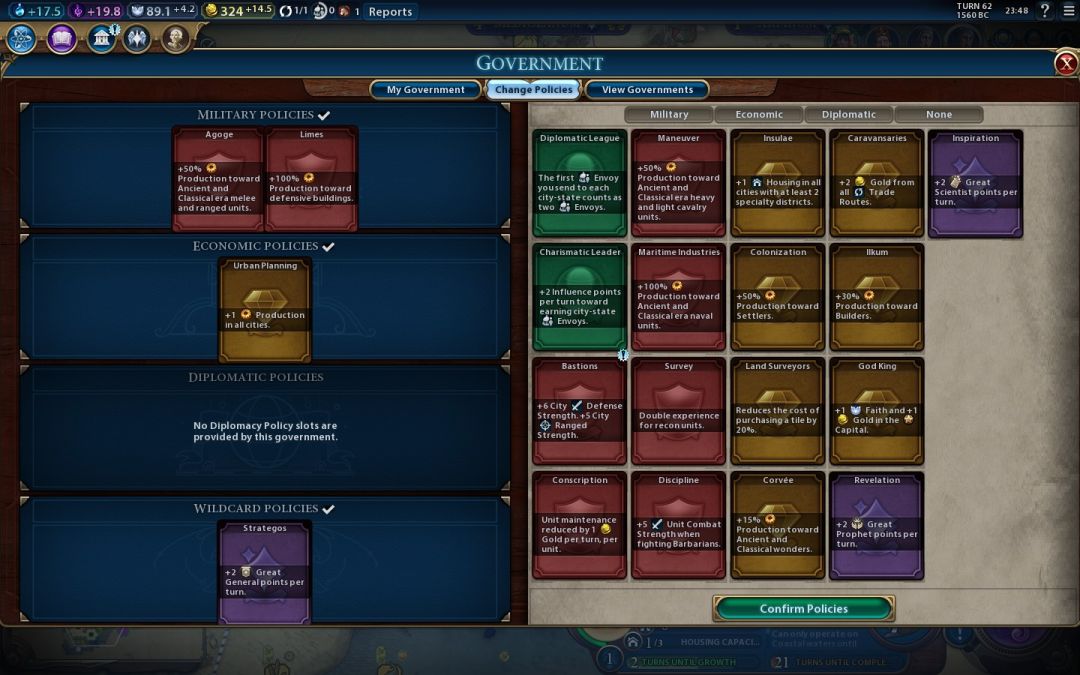
I also opted to change my government to Autocracy, losing the Diplomatic policy slot in exchange for more Military policies. The passive benefits of Autocracy are +15% bonus to wonder construction (useless here) and +1 to all yields in the capital. Not tile yields, yields: you get exactly +1 production, +1 culture, +1 beakers, etc. Autocracy is generally pretty good in Civ6 in the early game, since the Diplomatic policies are weak and this government can still deliver 2 Military and 2 Economic policies. I actually think Autocracy will be even better in Multiplayer where the Military policy slots have a lot more value. For this game though, I would only be in this government for about 10 turns before switching over to Oligarchy for the combat bonuses.
I picked up Agoge to help train some warriors for upgrading, Limes to build the walls in Aquileia and exploit the production overflow sort-of-bug into a horseman, and Urban Planning because it still remained an awesome policy. I considered dropping Strategos from the Wildcard slot, but I still needed about 19 more Great General points for completion and the Encampment wasn't quite done yet in the capital. There was nothing else too urgent that I need in that Wildcard slot right now, so better safe than sorry. I would end up running Strategos until the next policy swap and then pick up something else.
While this was taking place, my capital finished the Encampment for my district on Turn 64; this was the Great Person screen at the time:

Teh was clearly going to claim the first Great Scientist in about a dozen more turns, and Yuris showed up for the first time as a result of his Campus district finishing on Turn 62. Otherwise, there was no movement here on any of the other Great People. In general, there wasn't a lot of interest in this side of the gameplay in this first PBEM game for Civ6.
Regarding Yuris' early Campus district that produced that 1 Great Scientist point, this was likely a poor decision. The Aztec tech rate went up by exactly 1 beaker/turn as a result of that district completing. This was pretty much why I stayed away from any early Campus districts: on this map with few mountains, they looked to be weak in the early game. Investing roughly 120 production for 1 beaker/turn was a terrible return initially. Now you do want those Campus districts eventually, because libraries are worth 2 beakers/turn, universities are worth 4 beakers/turn, and research labs are worth 5 beakers/turn, plus the beaker yield of all buildings is doubled with the vital midgame Rationalism policy. You can't rely on raw population forever in Civ6, and you do need the districts at some point. However, while there's still free land on the map to claim, building upwards with the districts is a bit of a sucker's investment from what I can see. Better to push outward and claim more land, then go back and build upwards with districts in the midgame. Teh and I had been following that philosophy, and I think that was why we ended up the best positioned for this game in the longterm. It would be different if this map had one of those mountain ranges that allows for a 5 beaker Campus district bonus, which could then be doubled to 10 beakers with the Natural Philosophy policy... but there was nothing like that here.
With Agoge policy back in place, my cities began cranking out warriors for legion upgrades:
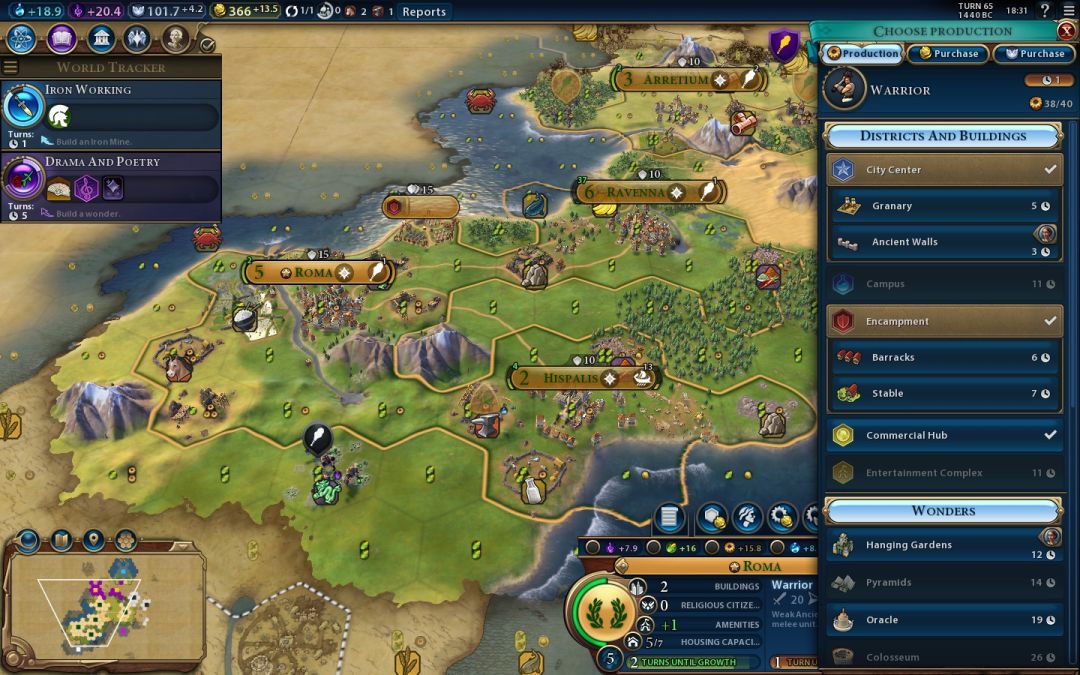
I had my original two warriors, and I was building a total of four additional new ones for upgrading purposes. The builder in this screenshot added a mine on the iron resource at Hispalis, boosting Iron Working tech in the process. I swapped back to Iron Working for this screenshot, but did *NOT* finish the tech itself, swapping back to Shipbuilding again afterwards. Once I finished Iron Working, I couldn't build warriors any longer, and that was bad. Warriors cost 40 production while legions cost 110 production - a bit of a difference. I planned to finish the trio of warriors in production here and then finish the tech after that.
As the warriors completed, I began moving them into position on the western coast. Most of them would upgrade to legions on Turn 70 and then hop into the water on Turn 71. I realized that I would only have enough money on hand to upgrade three legions on Turn 70, however, so one of the warriors was planned to embark on Turn 70 and then upgrade while already in the water on the fish tile on Turn 71. That was the only water tile in my borders, and therefore the only place I could pull that little trick to save myself a turn of movement. Then everyone would move out together on Turn 72, arrive next to TheArchduke's territory on Turn 74, and disembark back onto land + declare war on Turn 75. If all went as I hoped, TheArchduke's capital would be mine on Turn 76. As it wrote at the time, it was going to be an exciting result one way or another in ten turns.
On Turn 67, I pulled off the forest chop overflow move discussed earlier:
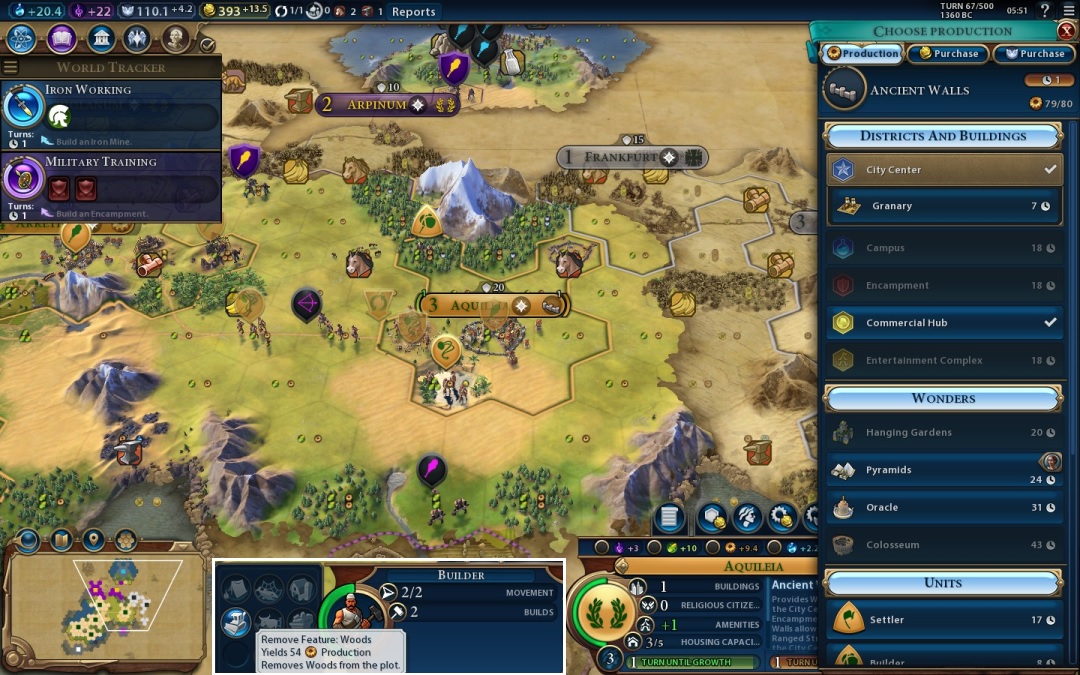
|
Sullla: Over at Aquileia, we had a tutorial this turn on how to utilize (exploit?) production overflow in Civ6. For starters, I've been building Ancient Walls the last few turns with the Limes policy in place for +100% production on defensive structures. It's something that you never need to use in Single Player games, but is actually an excellent policy here in Multiplayer. It makes walls very cheap indeed to build, and walls are critical for defense against other humans. Somewhat unintentionally, I ended up at 79/80 production into the walls here at Aquileia, which is absolutely perfect from a production standpoint. I've already been getting +100% production while building the walls. Now I can get +100% production into whatever else I overflow into for my next build, magnified by the effects of the forest chop I have lined up. I pasted in the production bonus from the forest chop at the bottom of the screenshot. It says that a forest chop is worth 54 production, which gets doubled to 108 production, then that gets added to the 79/80 production currently invested into the city walls. Aquileia ends up with 187/80 production, which instantly finishes the walls and then overflows 107 production into the next build: 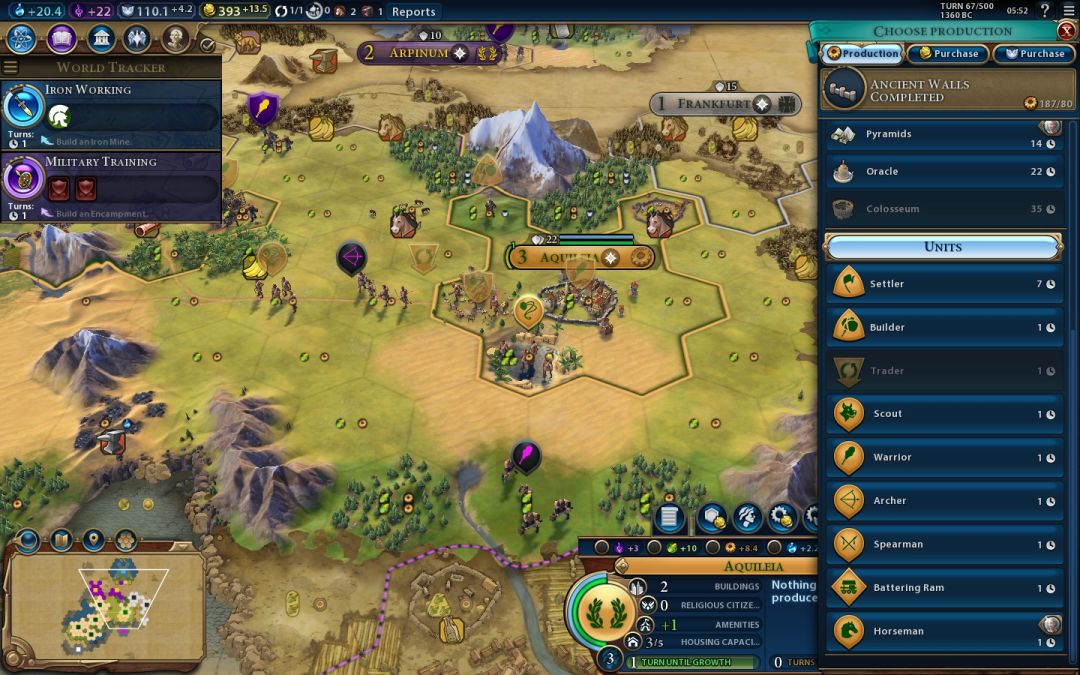
Yep, the production from chopping forests/jungles or harvesting a resource happens immediately in Civ6. You do not have to wait for the next turn's production cycle - those walls appear instantly on the map. And then I get the real benefit: the 107 production overflow. Say hello to the 1-turn horseman unit that I've been predicting for the last week or so. |
The use of that forest chop effectively gave me a horseman for free, adding a good amount of striking power to my invasion force. The legions would do the most damage, but I figured it would be highly useful to have a unit with 4 movement (5 with the Great General) around for some additional maneuverability. Note as well that I also set up a civic to complete on this turn for a policy swap. That allowed me to drop the Limes policy (and Agoge since I could no longer build warriors) in favor of Conscription's -1 gold/turn per unit and Maritime Industries' +100% production on naval units. With that latter policy in hand, I moved to set up a similar forest chop at Hispalis. There was just one problem: the game wouldn't let me chop the forest in question!

|
Sullla: Oh you've got to be kidding me! I couldn't chop the forest at this city because there was already a plantation on the tile. This is probably going to delay my attack by one turn, since I had to waste a turn removing the plantation with my builder. (And now I need to burn another builder charge later to re-add that plantation back again! Sheesh.) In a worst case scenario though, I can choose to go harvest the stone if the game won't allow me to chop the forest next turn. I'm pretty confident that it will, but I do have that as a backup in my pocket. And I'll have enough beakers to insta-complete Shipbuilding tech once the boost hits without having to wait for the end of a turn to arrive, so I can still embark starting on Turn 70 even in the worst case possible. This is mostly just annoying... although it does guarantee that I'll never forget about how this mechanic works ever again, since it hit at such an important moment here. |
Let this be a warning to all other Civ6 players: you cannot chop a forest/jungle tile that has a plantation on it. The rule makes no sense at all, since you can chop the forest and then build a plantation, but apparently you can't go in the other direction. Fortunately, I was indeed able to chop that forest (after removing the plantation - poor Hispalis!) and get those galleys out as planned. It didn't even wind up costing me a turn on my attack plan, thank goodness. What a weird little quirk in the game mechanics.
In another sign of a plan coming together, my Great General appeared outside my capital on Turn 68:
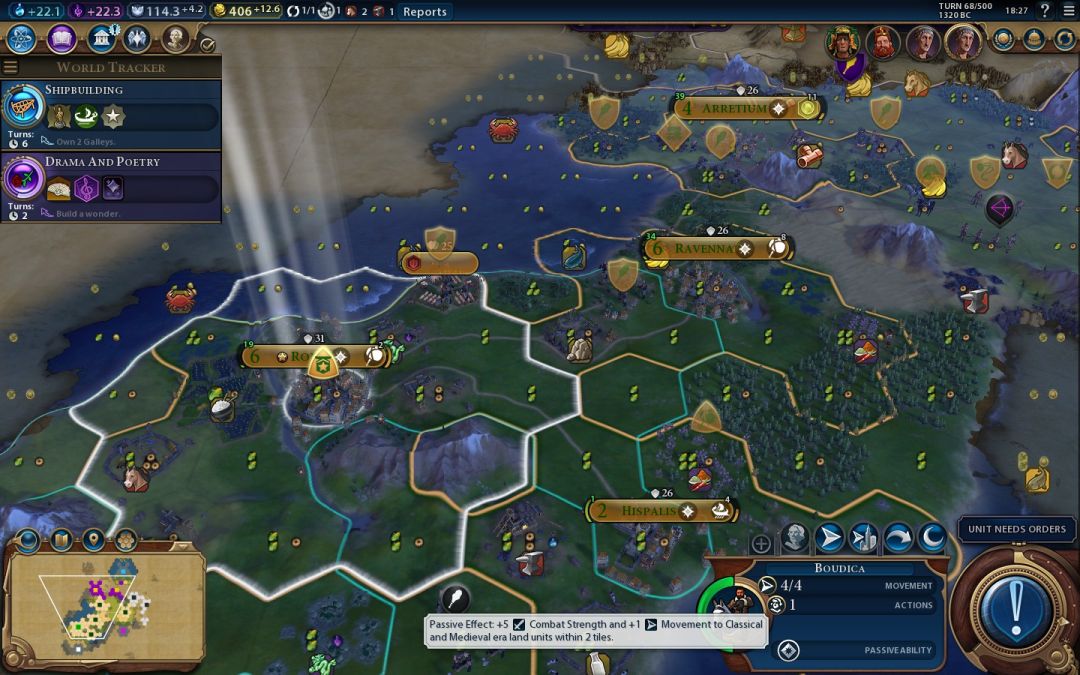
Boudica was my Great General. I took that as a good sign, having a Civ4 leader marshalling my forces. (Even better, Genghis Khan Temujin was slated as the next one in the pipeline for the Medieval era.) The picture above displays the specific bonus: +5 combat strength and +1 movement for all Classical and Medieval units within 2 tiles. Interestingly, this meant the bonus did not apply to warriors and archers, which are Ancient era units. However, it definitely did apply to legions and horsemen... and will remain in effect for crossbows and knights later on. The Celtic queen was going to be integral to the success of this plan, and I moved her to join the rest of my gathering army.
The forces of southern Rome were assembling on the coasts:
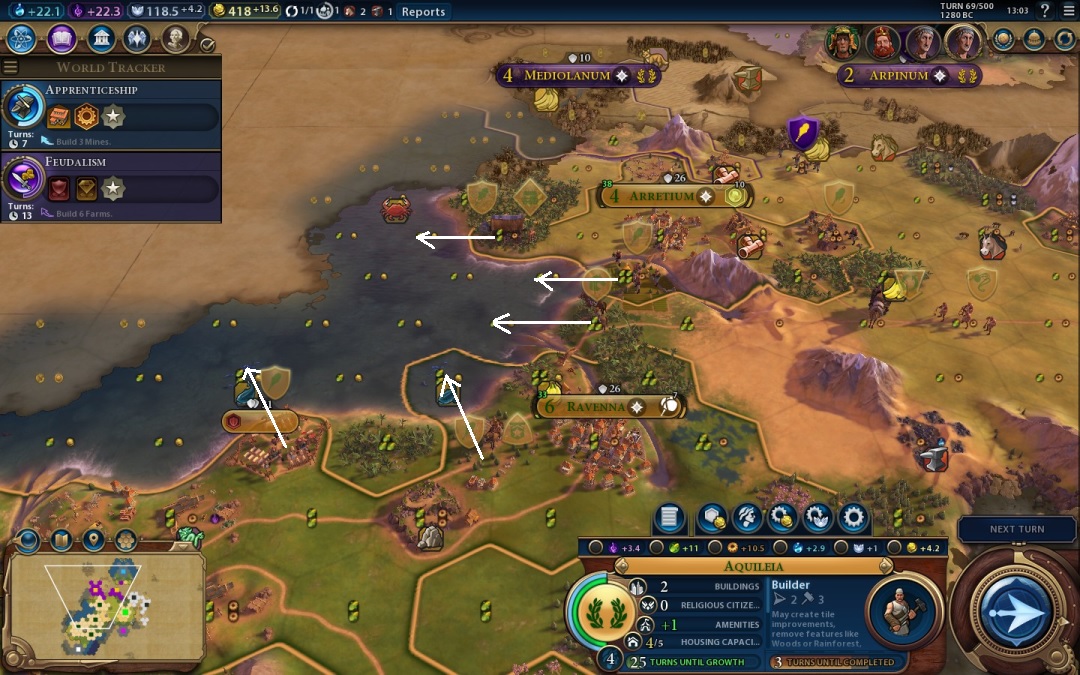
|
Sullla: Finally, here are the units preparing to head off to war; I've drawn in the arrows where they will be embarking shortly. The battering ram, the horseman, and the Great General will be hopping into the water next turn, while most of the warriors will be upgrading into legions and then embarking on Turn 71. However, I don't have enough money for three legion upgrades next turn, so the warrior paired with the Great General will hop into the water next turn (Turn 70), and then upgrade on the one water tile within my borders on Turn 71. Thus, all legions are in the water and upgraded by the end of Turn 71. Nifty little tactical moves if I do say so. Now normally embarked units only get 2 movement while at sea without researching additional techs... except that I have the Great General, so those legions and the horse will get 3 movement per turn, and that's a significant boost. The army spends Turns 72 and 73 moving across the water, Turn 74 moving right up to the coast, and then Turn 75 disembarking and declaring war. With luck, TheArchduke's capital falls on Turn 76 to five separate attacks from the 4 legions and 1 horseman. And if that all works, this war is over before it even properly gets started. |
I had researched Shipbuilding tech slightly past 50 percent completion, and so when the second galley completed in Hispalis at the start of Turn 70, the tech instantly completed. My Great General, horseman, battering ram, and one warrior hopped into the water, while the other three warriors were upgraded into legions:
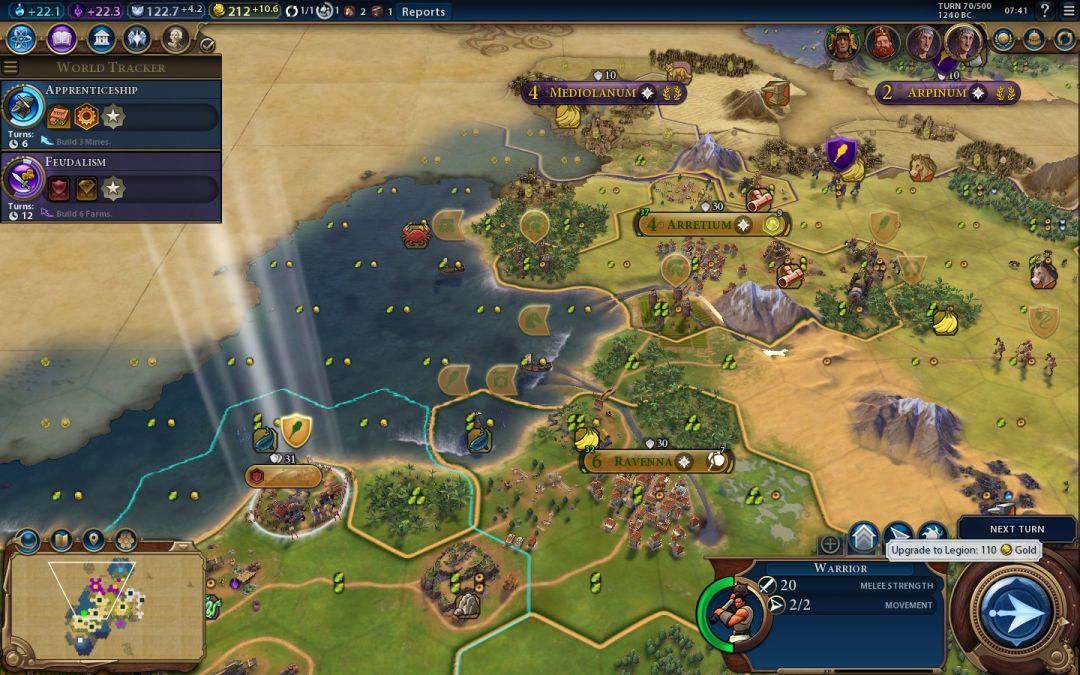
Each warrior -> legion upgrade cost 110 gold, the number I had been shooting for since the start of this game. Since warriors cost 40 production each and legions cost 110 production each, I was converting 440 gold into 270 production via these four upgrades, and that was an insanely good return on investment. Better than 1.5 to 1, while cash-rushing something with gold costs 4 gold per point of production. Not even close; for whatever reason, upgrading is enormously cheaper than cash-rushing. The one downside here was that warriors cost nothing in maintenance while legions cost 2 gold/turn in upkeep; I was blunting that cost by running the Conscription policy, but I still ended up with -1 gold/turn for each legion. As expected, I was just short of having enough money this turn for all four of my warrior -> legion upgrades. I therefore upgraded three warriors and sent the fourth one into the water on my fish resource, where I would be able to upgrade it next turn. The horseman unit would head out in front of the legions as a vanguard scouting force, while being careful to avoid getting spotted by TheArchduke's borders.
The army (or was it an armada?) sailing towards northern Rome:
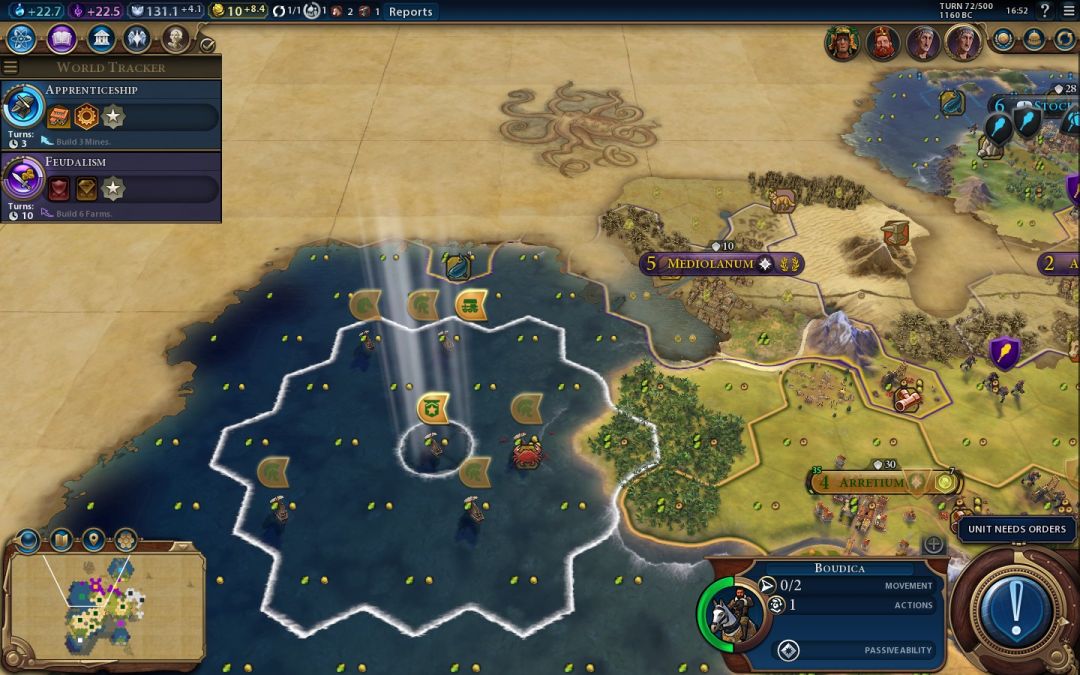
Kind of weird looking, no doubt about it. 
The most important thing on my mind as my units approached TheArchduke's territory was whether he would be able to produce a single legion of his own. This was due to the way that city defenses are calculated in Civ6: "The strength of the city is the strongest unit you've ever built minus 10. Capital gives +3, districts give +2 each. Hills' bonus won't ever show up, but is active when attacking the city - it's the same as with units fighting. Garrisoning a unit will increase the strength of the city to the strength of the unit, if higher. Thus garrisoning your strongest unit is +10. Walls shoot with the strength of your strongest ranged units from both the archers and the artillery lines." In other words, building even one melee unit of your best type upgrades all city defenses everywhere.
Up to this point, my strongest unit had been a warrior (melee strength 20). That meant all my cities had the default strength of 10, and if I had a warrior stand inside the city, its defensive strength increased to 20. I had been keeping a warrior outside both of my frontline cities (Arretium and Aquileia) for exactly this reason, to increase the defensive strength if they would come under attack. A city with 20 strength is obviously a lot more sturdy than one with 10 strength. Now that I had a horseman (strength 35) and legions (strength 40), the default city strength became 30. With a legion standing in the city, its strength went up to 40, and city walls could add another +3 defense, which was VERY strong for this early in the game. On the positive side, no one was going to crack my cities without horses and swords, and in pretty decent numbers. Aquileia looked pretty safe even with my units heading off to the other side of the world. On the negative side, that applied to TheArchduke as well: I would know the instant that he finished a legion, because his cities would also leap up to 30 defensive strength. That was a major reason why I was trying to move fast here. Even one legion would make a massive difference in attacking his cities.
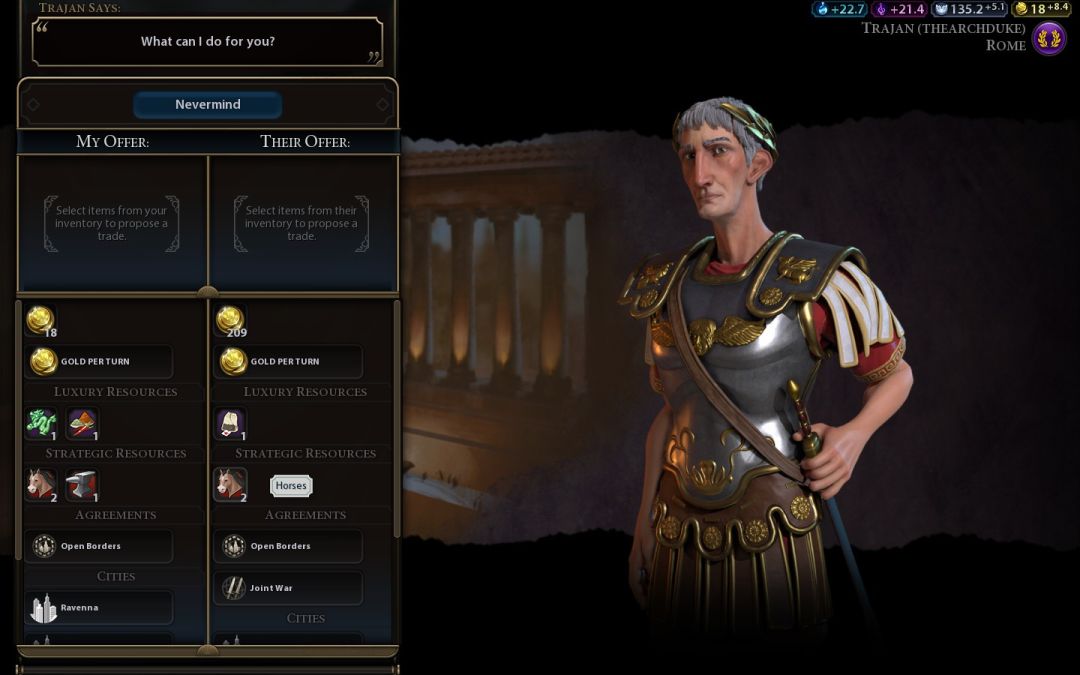
The key determining factor could actually be the amount of gold in the treasury, believe it or not. That 209 gold in TheArchduke's treasury was a real threat, enough for a pair of warrior -> legion upgrades after he topped 220 gold on the following turn. Here was the more pressing question: did TheArchduke even have Iron Working tech? I didn't think so; I guessed that he was pushing for Apprenticeship tech, since TheArchduke hadn't discovered anything in the last few turns, and I knew his last two techs were Currency and Horseback Riding. That was only a guess though, and it was possible that one of his techs was Iron Working. I would certainly find out soon enough. If TheArchduke lacked that tech, then he was basically dead, because there would be nothing stopping me from taking his capital on Turn 76 and that would be that. TheArchduke wouldn't get a chance to switch his research until the start of Turn 75, and that would only leave a single turn's worth of research before the attack came in on Turn 76. Surprise was the critical factor in this attack: had I managed to pull this off without tipping off my northern neighbor?
On Turn 74 I swapped into Oligarchy government for the +4 strength to melee units and the experience bonus. I gained no advantage here, as TheArchduke was also running Oligarchy and had been doing so for some time now, a somewhat odd choice for peacetime. With all my city management for the turn out of the way, I declared war and moved in:

|
Sullla: And here's the main action on the shores of northern Rome. There were no military units waiting to meet my invasion force, only a trader shuttling back and forth and a builder up on a grassland hill tile. I think it's fair to say that this attack is going to catch him off-guard. The tactics here are pretty simple: next turn, all four of the legions land and then they attack together on Turn 76. The horseman will actually stay in the water; I need a unit to occupy the water tiles in order to put the city fully under siege, and prevent it from being able to heal back between turns. The horseman can also attack straight from the water, although only at the weak embarked strength of 15. (This was another change in a recent patch; originally, embarked units had their full strength and it was pretty silly that knights would be swimming around with 48 strength, barely getting scratched by frigates.) At a current city defensive strength of 13, this capital is complete toast to the attack force I've brought. Even at a defensive strength of 33, which is what it will be if a warrior -> legion upgrade goes through for TheArchduke, this spot should still fall pretty easily. Unless there's something out there in the fog that I can't see right now, this looks like it should be a success. I can also now spot where one of TheArchduke's other cities is located: off to the northwest, tucked into the back corner of his peninsula. That's a weak location with just a wheat resource and some hill tiles to its name. I can settle the same mirrored spot myself, although it's very far down my list of places to settle, and probably not worth expending a city on. Still, since he went to all the trouble of building a settler, I'll be happy to capture it if all goes well. Tactically, I think I will likely head for Mediolanum next if I'm successful here at the capital. It's the second-largest city that TheArchduke has, and probably his second best location after the capital, despite the lack of production. It would also be nice to establish a road and cultural connection back to my own cities for tactical reason - I'm pretty exposed up here with my units behind enemy lines right now. Still, let's not get ahead of ourselves yet. TheArchduke's capital first, and then we'll reevaluate from there. 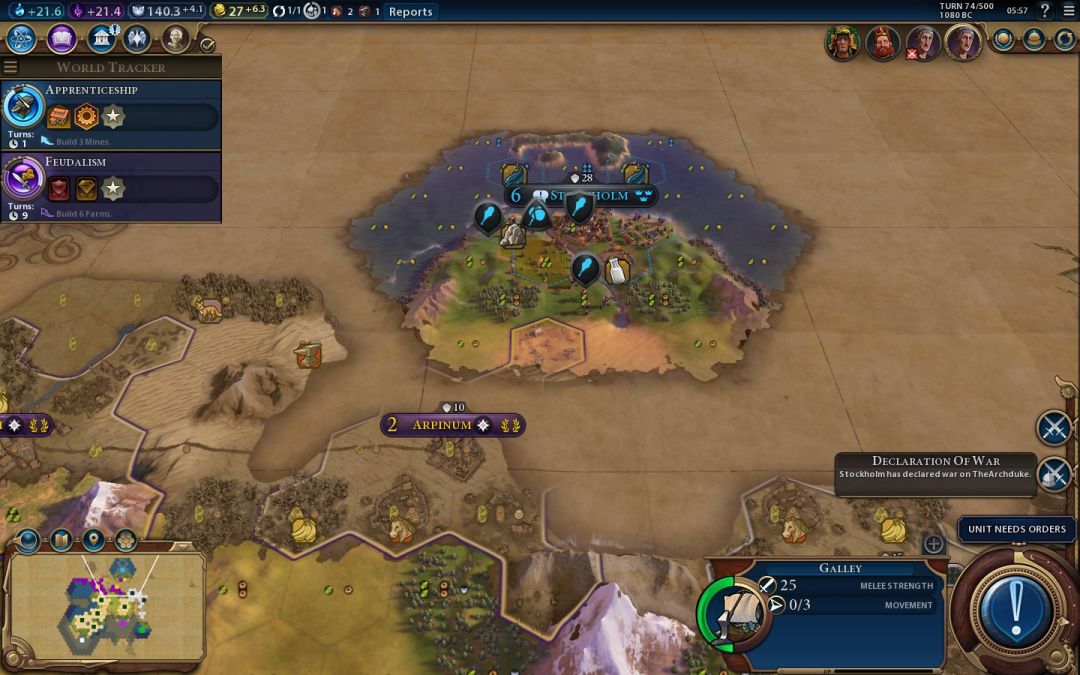
Hah, I had actually forgotten this would happen. I'm the suzerain of Stockholm, and therefore it follows me into war with other civs. That should give TheArchduke another something to worry about over here at Arpinum. Don't overlook the city states in this game! (In practice, the units from the city states won't stray too far away from their home. I don't think they ever go more than 5-6 tiles away from their city. However, Arpinum is close enough to Stockholm that they might rough up the city a bit. And I'm about to have 2 envoys saved up in reserve so I can easily maintain my suzerain status here. It's nice to be the runaway leader in culture and have all those free envoys from the civics tree.) |
This was my crossing of the Rubicon moment for the PBEM1 game, and as Caesar famously said, the die had been cast. The critical actor in this drama was now TheArchduke: did I catch him by surprise, and how would he react?
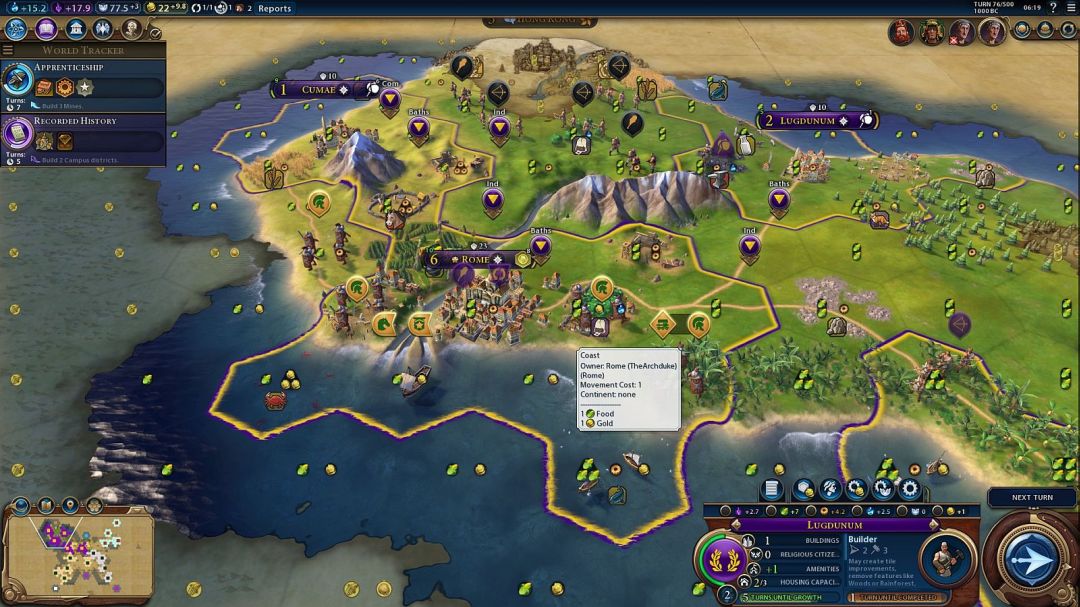
|
TheArchduke: Yep, that is pretty much it, 5 legions landing next to my capital next turn. I would have 3 legions in 3 turns, way too slow for Sullla who has a Great General as well. Sullla is way more efficient then me and +1 production for flood plains did the rest. I doubt the others will wake up soon enough. Good game, we will see how quick I die. I am rushing towards the capital with my units and will have legions in 2 turns. Exactly too late. I doubt my bought warrior will do much but delay the inevitable this turn the fall of my capital. |
As it turned out, TheArchduke did not have Iron Working tech when my attack arrived. He had researched it to the halfway point and then ceased further teching while waiting for a builder to mine his iron resource, which would complete the tech. That builder was on its way and had reached the iron tile in the above picture, but it still needed more time to get the mine finished and boost the tech to completion. Iron Working and legions would not arrive in time for the battle over TheArchduke's capital.
Even better for me, TheArchduke had spent his whole treasury, and not on warrior to legion upgrades. He upgraded two slingers into archers for a cost of 30 gold apiece, and then spend 160 gold cash-rushing a warrior to completion inside his capital. In the immediate context here, the warrior raised the defensive strength of the enemy capital from 13 to 23, and that did make the city noticeably harder to take... at the cost of effectively ruling out any future warrior into legion upgrades. TheArchduke would now have to build them slowly at 110 production each, or find some other way to reach 110 gold for upgrades, which was a long distance off now. He had only 22 gold in his treasury and was making just under 10 gold/turn.
I'll let my turn report do the talking here from Turn 76:

|
Sullla: First I attacked with the battering ram legion to the east of the city. With no walls in place, the battering ram appears to have had no effect at all on the attack. Oh well, that's not a big deal. The battering ram will remain relevant for the rest of the game, and I had to assume that I'd face city walls in this attack, because if I didn't plan for them and they were there, I'd have been in some serious trouble. I will decouple the legion from the ram next turn to get the 3 movement points back. That legion took all of 11 damage in the first attack and knocked out about 45% of the city's health. The second legion attacked from the northeast tile; it took 8 damage and knocked the city down to a sliver. I wanted to use the horseman attacking from the sea to capture the city, since that would allow the two western legions to start moving on to the next city already. However, at only 10 strength it wasn't quite enough to get the job done. So I used the highlighted legion to strike the fatal blow: 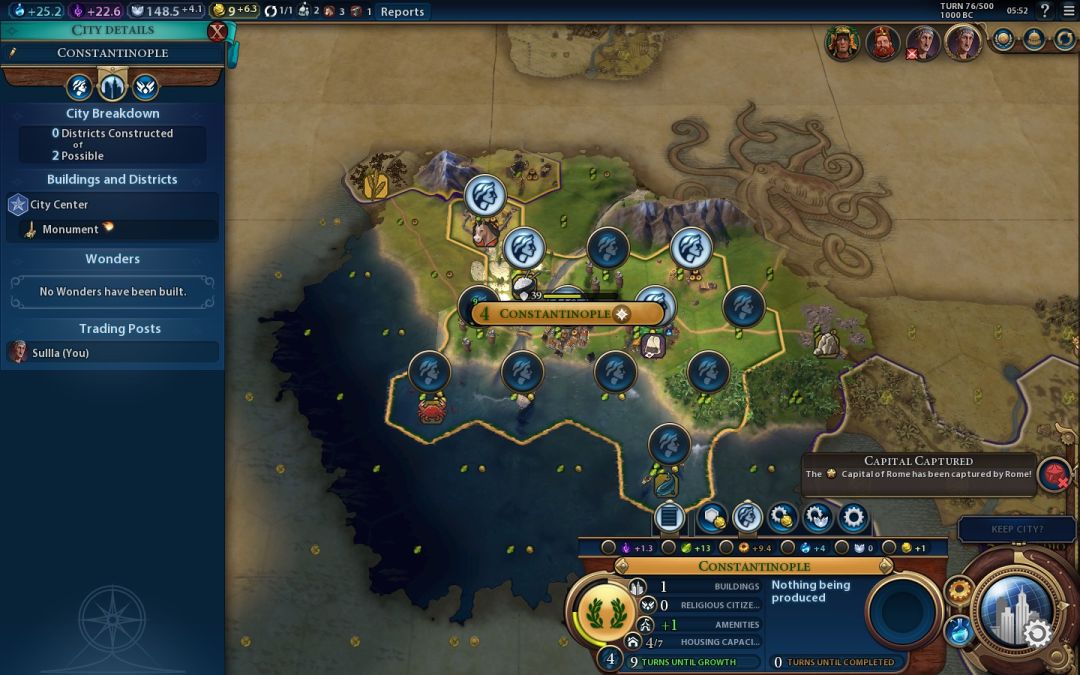
Of course there was only one name possible for the newly taken city, as the second capital of the Roman Empire. Say hello to Constantinople. For that matter, check out the pop-up message over there in the corner: the capital of Rome has been captured by Rome! Constantinople lost two population points upon capture, dropping from size 6 to size 4. The only infrastructure that survived capture was the city monument, which is sitting at 45/60 production and will need to be repaired. Too bad TheArchduke didn't construct any districts here; the ones that were in-progress actually disappeared off the map when I took the place. I ended up replacing the Commercial district in the same spot, at the mouth of the river one tile west of the city. I'll put the bath district northeast of the city once it becomes available. This way, if I build a Harbor district later, it can be next to the Commercial district and the crab resource for a huge adjacency bonus. I realize that I forgot to take an overview picture of my units following the capture of Constantinople. There's not too much to report here overall; I landed the horseman unit west of the city, and moved the one legion that didn't attack to the northwest, towards the city of Cumae. It's size 1 and has 10 defensive strength, so I think I can take it pretty easily. I will likely heal the three units that took damage next turn, restoring all of them to full strength, and use the legion and horseman to attack Cumae. I think I can capture that little city on Turn 78. ***** TheArchduke: Basically Sullla did not caught me with my pants down. Sullla caught me with my pants down, my mobile phone on 1% and dying with no connection bar whatsoever and my shoes on a tree. |
The initial strike was therefore a success!  A huge smashing success, going pretty much exactly how I had hoped it would when I drew it up weeks in advance. But no plan ever fully survives contact with the enemy, and despite taking TheArchduke's capital, my army was now stranded behind enemy lines deep inside northern Roman territory. Furthermore, capturing another player's capital city put a huge target on my backside, as I would be all but certain to win if I wasn't stopped from conquering TheArchduke's territory. At home, my huge military had sent my economy into the doldrums, and I was barely making a profit in gold/turn income. This war would not be as neat and easy as I had hoped, and it would pull in additional civs before the dust finally settled.
A huge smashing success, going pretty much exactly how I had hoped it would when I drew it up weeks in advance. But no plan ever fully survives contact with the enemy, and despite taking TheArchduke's capital, my army was now stranded behind enemy lines deep inside northern Roman territory. Furthermore, capturing another player's capital city put a huge target on my backside, as I would be all but certain to win if I wasn't stopped from conquering TheArchduke's territory. At home, my huge military had sent my economy into the doldrums, and I was barely making a profit in gold/turn income. This war would not be as neat and easy as I had hoped, and it would pull in additional civs before the dust finally settled.



